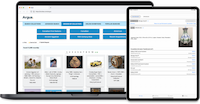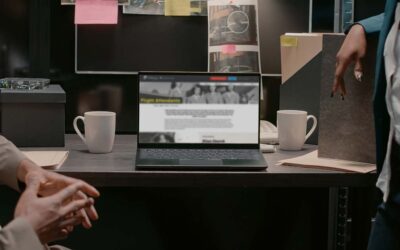Museum Exhibit Design as Storytelling Infrastructure

Rachael Cristine Woody
Exhibit design provides the infrastructure needed in order for stories to materialize. Before we consider how to translate the story told through physical exhibition to digital, it is important to understand how the physical aspects of the design support the story as it unfolds. These design mechanisms are the ones we will want to translate to the digital realm. In this post, we will review the three central aspects of storytelling with exhibit design.
Storytelling Infrastructure
Storytelling infrastructure in exhibit design includes:
- The Story Path
- Storytelling Performance Types
- Sensory Setting
Museum Exhibit Design: The Story Path
There are numerous resources to explain story structure, common story paradigms, and other elements in the traditional mix of storytelling. The first foundational element is the story path. The story path is the structure on which the story is built, and in a physical exhibit space, is the physical pathway visitors take as they travel through the exhibit.
There are two types of story paths:
- Linear Pathway: There is only one physical pathway through the exhibit and therefore, only one true way to experience the story.
- Multiple Pathways: There are several physical story pathways that can be taken. While there is a sense of beginning, middle, and end, there is no wrong way to progress through the story.
Regardless of which type of path is taken, there should be a clear sense of beginning, middle, and end. This helps to orient the visitor within the story as well as assure them they can finish the journey. In physical exhibit spaces, it is possible to execute either path type—so the decision regarding path type rests on which suits the story best.
Museum Exhibit Design: Storytelling Performance Types
In addition to determining a pathway type, we must consider how we intend to perform the story. As we explored in an earlier series, storytelling can be performed in several ways:
- Oral: Narration, oration, recitation, interviews, conversation
- Written: Exhibit panels, documents
- Visual: Objects, drawings, graphics, photographs, visual media
In most storytelling venues, a primary performance type is chosen. In books, it is the written word. On scripted TV shows or movies, it’s the combination of visual and oral performance based upon written material. In a physical exhibit space, there is typically a preference for the visual, with written material provided on panels to aid in the storytelling. Increasingly, audio-visual materials and digital content that can increase visit engagement at specific points within the exhibit are included.
Museum Exhibit Design: Sensory Setting
Finally, once a story pathway and storytelling performance types are selected, there are the sensory aspects to consider. Sensory elements are used to help provide an atmosphere for the story—and can even be used to help enhance a portion of it.
Five ways to set the story atmosphere:
- Lighting: Position and intensity of lighting the objects as well as overall lighting for the space can help set the mood for the story.
- Sound: Narration, interviews, music, and even soundscapes are options for conveying a portion of the story or helping create the atmosphere.
- Color: The use of color is a subtle way of conveying a mood or signaling a tone shift. Humans interpret colors as emotions, so they are used to both attract attention as well as convey an emotion that may otherwise be ambiguous.
- Texture: Design elements with texture can also aid in setting an atmosphere. A rough, sharp texture can signal danger or wariness. A smooth and pleasing texture can engender a sense of peace and satisfaction. Regardless of whether a visitor can touch the elements, they can still subliminally pick up on how the textures in the room help set the tone.
- Temperature: In an exhibit setting it can be difficult to deploy temperature changes if they’re not suitable for the objects. However, if an exhibit area can be made colder, warmer, dry, or humid, the visitors feel the shifts in the (in this case) literal atmosphere of the space.
While all sensory elements should be considered for inclusion, they should be deployed thoughtfully as it is possible to overwhelm with clashing sensorial elements.
Setting the Foundation, Translating to Museum Digital Exhibits
There are many design elements to deploy, but selecting specific foundational pieces will help set the tone and also help museum staff narrow down all successive decisions. While we are used to thinking of these decisions in a physical space, many of these elements readily translate to a digital platform (like Lucidea’s CMS for museums). We will explore this translation in our next post.

Rachael Cristine Woody
Curious about this topic? Please join us for the companion webinar, Storytelling Design: Translating the Physical to Digital, January 29 at 11 a.m. Pacific, 2 p.m. Eastern. (Can’t make it? Register anyway and we will send you a link to the recording afterwards). Register now or call 604-278-6717.
**Disclaimer: Any in-line promotional text does not imply Lucidea product endorsement by the author of this post.
Never miss another post. Subscribe today!
Similar Posts
An Introduction to Scrollytelling for Museums
Discover how museums use scrollytelling and digital storytelling platforms to create immersive narratives. This introduction explores key concepts and approaches to interactive storytelling.
Exploring Self-Determinate Multiple Pathways: An Example of Digital Storytelling
Discover how self-determinate multiple pathways offer flexible interactive storytelling in museum exhibits. Learn from the Tenement Museum’s ‘Your Story Our Story.’
Digital Museum Storytelling Example: A Look at Self-Determinate Linear Pathways
Self-determinate characteristics on a linear pathway go beyond brief sidebar topics and instead offer alternative ways to navigate the linear pathway.
Digital Storytelling in Museums: The Prescriptive Linear Pathway in Action
Rachael Woody emphasizes that storytelling is key to engaging audiences with collections. One effective approach? The prescriptive linear pathway—a simple yet powerful method for guiding visitors through digital exhibits.







Leave a Comment
Comments are reviewed and must adhere to our comments policy.
0 Comments